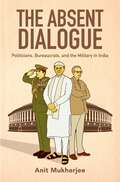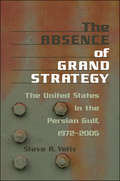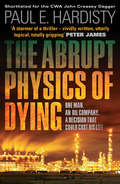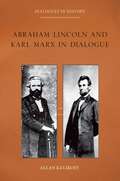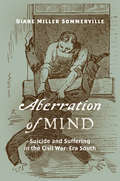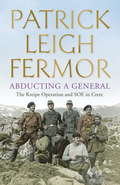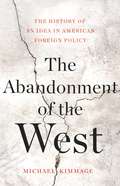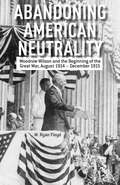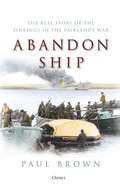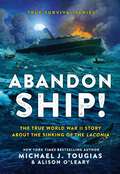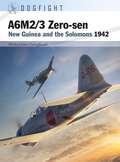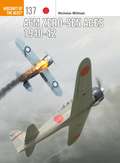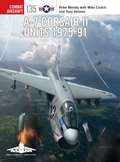- Table View
- List View
The Absent Dialogue: Politicians, Bureaucrats, and the Military in India (Modern South Asia)
by Anit MukherjeeCivilian control over the military is widely hailed as one of the major successes of India's democracy. Because it is so rare, especially among post-colonial states, this control is rightfully celebrated. But has this come at a cost? In The Absent Dialogue, Anit Mukherjee argues that the pattern of civil-military relations in India has hampered its military effectiveness. Diving deep into understanding the organization and internal processes within the Indian military, he explains how Indian politicians and bureaucrats have long been content with the formal and ritualistic exercise of civilian control, while the military continues to operate in institutional silos. Yet, there has been little substantive engagement between the two. To support this claim, Mukherjee closely examines the variables most closely associated with military effectiveness-weapons procurement, jointness (the ability of separate military services to operate together), officer education, promotion policies, and defense planning. Further, Mukherjee shows how India's pattern of civil-military relations-best characterized as an absent dialogue-adversely affects each of these processes. While the book focuses on India, it also highlights the importance of civilian expertise and institutional design in enhancing civilian control and military effectiveness in other democracies. Informed by more than a hundred and fifty interviews and recently available archival material, The Absent Dialogue sheds new light on India's military and will reshape our understanding of both the history and contemporary dynamics of civil-military relations and recurring problems therein.
The Absence of Grand Strategy: The United States in the Persian Gulf, 1972–2005
by Steve A. YetivGreat powers and grand strategies. It is easy to assume that the most powerful nations pursue and employ consistent, cohesive, and decisive policies in trying to promote their interests in regions of the world. Popular theory emphasizes two such grand strategies that great powers may pursue: balance of power policy or hegemonic domination. But, as Steve A. Yetiv contends, things may not always be that cut and dried. Analyzing the evolution of the United States' foreign policy in the Persian Gulf from 1972 to 2005, Yetiv offers a provocative and panoramic view of American strategies in a region critical to the functioning of the entire global economy. Ten cases—from the policies of the Nixon administration to George W. Bush's war in Iraq—reveal shifting, improvised, and reactive policies that were responses to unanticipated and unpredictable events and threats. In fact, the distinguishing feature of the U.S. experience in the Gulf has been the absence of grand strategy.Yetiv introduces the concept of "reactive engagement" as an alternative approach to understanding the behavior of great powers in unstable regions. At a time when the effects of U.S. foreign policy are rippling across the globe, The Absence of Grand Strategy offers key insight into the nature and evolution of American foreign policy in the Gulf.
The Abrupt Physics of Dying (Claymore Straker #1)
by Paul E. HardistyOne man. An oil company. A decision that could cost his life.Claymore Straker is trying to forget a violent past. Working as an oil company engineer in the wilds of Yemen, he is hijacked at gunpoint by Islamic terrorists. Clay has a choice: help uncover the cause of a mysterious sickness afflicting the village of Al Urush, close to the company’s oil-processing facility, or watch Abdulkader, his driver and close friend, die. As the country descends into civil war and village children start dying, Clay finds himself caught up in a ruthless struggle between opposing armies, controllers of the country’s oil wealth, Yemen’s shadowy secret service, and rival terrorist factions.As Clay scrambles to keep his friend alive, he meets Rania, a troubled journalist. Together, they try to uncover the truth about Al Urush. But nothing in this ancient, unforgiving place is as it seems. Accused of a murder he did not commit, put on the CIA’s most-wanted list, Clay must come to terms with his past and confront the powerful forces that want him dead.A stunning debut eco-thriller, The Abrupt Physics of Dying will not only open your eyes, but keep them glued to the page until the final, stunning denouement is reached.‘A stormer of a thriller - vividly written, utterly topical, totally gripping' Peter James‘A page-turning adventure that grabs you from the first page and won’t let go’ Edward Wilson‘An exceptional debut, beautifully written, blisteringly authentic, heartstoppingly tense and unusually moving. Definite award material' Paul Johnston‘A thriller of the highest quality, with the potential to one day stand in the company of such luminaries as Bond and Bourne’ Live Many Lives‘A big, powerful, sophisticated and page-turning thriller – thought-provoking and prescient' Eve Seymour
Abraham Lincoln and Karl Marx in Dialogue (Dialogues in History)
by Allan KulikoffWhy put Abraham Lincoln, the sometime corporate lawyer and American President, in dialogue with Karl Marx, the intellectual revolutionary? On the surface, they would appear to share few interests. Yet, though Lincoln and Marx never met one another, both had an abiding interest in the most important issue of the nineteenth-century Atlantic world-the condition of labor in a capitalist world, one that linked slave labor in the American south to England's (and continental Europe's) dark satanic mills. Each sought solutions--Lincoln through a polity that supported free men, free soil, and free labor; Marx by organizing the working class to resist capitalist exploitation. While both men espoused emancipation for American slaves, here their agreements ended. Lincoln thought that the free labor society of the American North provided great opportunities for free men missing from the American South, a kind of "farm ladder" that gave every man the ability to become a landowner. Marx thought such "free land" a chimera and (with information from German-American correspondents), was certain that the American future lay in the proletarianized cities. Abraham Lincoln and Karl Marx in Dialogue intersperses short selections from the two writers from their voluminous works, opening with an introduction that puts the ideas of the two men in the broad context of nineteenth-century thought and politics. The volume excerpts Lincoln's and Marx's views on slavery (they both opposed it for different reasons), the Civil War (Marx claimed the war concerned slavery and should have as its goal abolition; Lincoln insisted that his goal was just the defeat of the Confederacy), and the opportunities American free men had to gain land and economic independence. Through this volume, readers will gain a firmer understanding of nineteenth-century labor relations throughout the Atlantic world: slavery and free labor; the interconnections between slave-made cotton and the exploitation of English proletarians; and the global impact of the American Civil War.
ABRAH LINCOLN & KARL MARX IN DIALOGUE C (Dialogues in History)
by Allan KulikoffWhy put Abraham Lincoln, the sometime corporate lawyer and American President, in dialogue with Karl Marx, the intellectual revolutionary? On the surface, they would appear to share few interests. Yet, though Lincoln and Marx never met one another, both had an abiding interest in the most important issue of the nineteenth-century Atlantic world-the condition of labor in a capitalist world, one that linked slave labor in the American south to England's (and continental Europe's) dark satanic mills. Each sought solutions--Lincoln through a polity that supported free men, free soil, and free labor; Marx by organizing the working class to resist capitalist exploitation. While both men espoused emancipation for American slaves, here their agreements ended. Lincoln thought that the free labor society of the American North provided great opportunities for free men missing from the American South, a kind of "farm ladder" that gave every man the ability to become a landowner. Marx thought such "free land" a chimera and (with information from German-American correspondents), was certain that the American future lay in the proletarianized cities. Abraham Lincoln and Karl Marx in Dialogue intersperses short selections from the two writers from their voluminous works, opening with an introduction that puts the ideas of the two men in the broad context of nineteenth-century thought and politics. The volume excerpts Lincoln's and Marx's views on slavery (they both opposed it for different reasons), the Civil War (Marx claimed the war concerned slavery and should have as its goal abolition; Lincoln insisted that his goal was just the defeat of the Confederacy), and the opportunities American free men had to gain land and economic independence. Through this volume, readers will gain a firmer understanding of nineteenth-century labor relations throughout the Atlantic world: slavery and free labor; the interconnections between slave-made cotton and the exploitation of English proletarians; and the global impact of the American Civil War.
Aberration of Mind: Suicide and Suffering in the Civil War–Era South
by Diane Miller SommervilleMore than 150 years after its end, we still struggle to understand the full extent of the human toll of the Civil War and the psychological crisis it created. In Aberration of Mind, Diane Miller Sommerville offers the first book-length treatment of suicide in the South during the Civil War era, giving us insight into both white and black communities, Confederate soldiers and their families, as well as the enslaved and newly freed. With a thorough examination of the dynamics of both racial and gendered dimensions of psychological distress, Sommerville reveals how the suffering experienced by Southerners living in a war zone generated trauma that, in extreme cases, led some Southerners to contemplate or act on suicidal thoughts.Sommerville recovers previously hidden stories of individuals exhibiting suicidal activity or aberrant psychological behavior she links to the war and its aftermath. This work adds crucial nuance to our understanding of how personal suffering shaped the way southerners viewed themselves in the Civil War era and underscores the full human costs of war.
Aberration of Mind: Suicide and Suffering in the Civil War–Era South
by Diane Miller SommervilleMore than 150 years after its end, we still struggle to understand the full extent of the human toll of the Civil War and the psychological crisis it created. In Aberration of Mind, Diane Miller Sommerville offers the first book-length treatment of suicide in the South during the Civil War era, giving us insight into both white and black communities, Confederate soldiers and their families, as well as the enslaved and newly freed. With a thorough examination of the dynamics of both racial and gendered dimensions of psychological distress, Sommerville reveals how the suffering experienced by Southerners living in a war zone generated trauma that, in extreme cases, led some Southerners to contemplate or act on suicidal thoughts.Sommerville recovers previously hidden stories of individuals exhibiting suicidal activity or aberrant psychological behavior she links to the war and its aftermath. This work adds crucial nuance to our understanding of how personal suffering shaped the way southerners viewed themselves in the Civil War era and underscores the full human costs of war.
Aberration of Mind: Suicide and Suffering in the Civil War–Era South
by Diane Miller SommervilleMore than 150 years after its end, we still struggle to understand the full extent of the human toll of the Civil War and the psychological crisis it created. In Aberration of Mind, Diane Miller Sommerville offers the first book-length treatment of suicide in the South during the Civil War era, giving us insight into both white and black communities, Confederate soldiers and their families, as well as the enslaved and newly freed. With a thorough examination of the dynamics of both racial and gendered dimensions of psychological distress, Sommerville reveals how the suffering experienced by Southerners living in a war zone generated trauma that, in extreme cases, led some Southerners to contemplate or act on suicidal thoughts. Sommerville recovers previously hidden stories of individuals exhibiting suicidal activity or aberrant psychological behavior she links to the war and its aftermath. This work adds crucial nuance to our understanding of how personal suffering shaped the way southerners viewed themselves in the Civil War era and underscores the full human costs of war.
Aberration of Mind: Suicide and Suffering in the Civil War–Era South
by Diane Miller SommervilleMore than 150 years after its end, we still struggle to understand the full extent of the human toll of the Civil War and the psychological crisis it created. In Aberration of Mind, Diane Miller Sommerville offers the first book-length treatment of suicide in the South during the Civil War era, giving us insight into both white and black communities, Confederate soldiers and their families, as well as the enslaved and newly freed. With a thorough examination of the dynamics of both racial and gendered dimensions of psychological distress, Sommerville reveals how the suffering experienced by Southerners living in a war zone generated trauma that, in extreme cases, led some Southerners to contemplate or act on suicidal thoughts. Sommerville recovers previously hidden stories of individuals exhibiting suicidal activity or aberrant psychological behavior she links to the war and its aftermath. This work adds crucial nuance to our understanding of how personal suffering shaped the way southerners viewed themselves in the Civil War era and underscores the full human costs of war.
Abducting a General: The Kreipe Operation and SOE in Crete
by Patrick Leigh FermorA daring behind-enemy-lines mission from the author of A Time of Gifts and The Broken Road, who was once described by the BBC as 'a cross between Indiana Jones, James Bond and Graham Greene'. Although a story often told, this is the first time Patrick Leigh Fermor's own account of the kidnapping of General Kriepe, has been published.One of the greatest feats in Patrick Leigh Fermor's remarkable life was the kidnapping of General Kreipe, the German commander in Crete, on 26 April 1944. He and Captain Billy Moss hatched a daring plan to abduct the general, while ensuring that no reprisals were taken against the Cretan population. Dressed as German military police, they stopped and took control of Kreipe's car, drove through twenty-two German checkpoints, then succeeded in hiding from the German army before finally being picked up on a beach in the south of the island and transported to safety in Egypt on 14 May.Abducting a General is Leigh Fermor's own account of the kidnap, published for the first time. Written in his inimitable prose, and introduced by acclaimed Special Operations Executive historian Roderick Bailey, it is a glorious first-hand account of one of the great adventures of the Second World War. Also included in this book are Leigh Fermor's intelligence reports, sent from caves deep within Crete yet still retaining his remarkable prose skills, which bring the immediacy of SOE operations vividly alive, as well as the peril which the SOE and Resistance were operating under; and a guide to the journey that Kreipe was taken on, as seen in the 1957 film Ill Met by Moonlight starring Dirk Bogarde, from the abandonment of his car to the embarkation site so that the modern visitor can relive this extraordinary event.
Abarat 2: Days Of Magic, Nights Of War (Abarat Ser. #2)
by Clive BarkerA dazzling fantasy adventure for all ages, the second part of a quartet appearing at two yearly intervals, richly illustrated by the author. Film rights sold to Disney for $8 million on the paintings alone.
The Abandonment of the West: The History of an Idea in American Foreign Policy
by Michael KimmageThis definitive portrait of American diplomacy reveals how the concept of the West drove twentieth-century foreign policy, how it fell from favor, and why it is worth saving.Throughout the twentieth century, many Americans saw themselves as part of Western civilization, and Western ideals of liberty and self-government guided American diplomacy. But today, other ideas fill this role: on one side, a technocratic "liberal international order," and on the other, the illiberal nationalism of "America First."In The Abandonment of the West, historian Michael Kimmage shows how the West became the dominant idea in US foreign policy in the first half of the twentieth century -- and how that consensus has unraveled. We must revive the West, he argues, to counter authoritarian challenges from Russia and China. This is an urgent portrait of modern America's complicated origins, its emergence as a superpower, and the crossroads at which it now stands.
Abandoning American Neutrality: Woodrow Wilson and the Beginning of the Great War, August 1914 – December 1915
by R. FloydDuring the first 18 months of World War I, Woodrow Wilson sought to maintain American neutrality, but as this carefully argued study shows, it was ultimately an unsustainable stance. The tension between Wilson's idealism and pragmatism ultimately drove him to abandon neutrality, paving the way for America's entrance into the war in 1917.
The Abandoned Daughter (The Girls Who Went To War #2)
by Mary WoodWill Ella ever find what she's looking for?Voluntary nurse Ella is haunted by the soldiers' cries she hears on the battlefields of Dieppe. But that’s not the only thing that haunts her. When her dear friend Jim breaks her trust, Ella is left bruised and heartbroken. Over the years, her friendships have been pulled apart at the seams by the effects of war. Now, more than ever, she feels so alone. At a military hospital in France, Ella befriends Connie and Paddy. Slowly she begins to heal, and finds comfort in the arms of a French officer called Paulo – could he be her salvation?With the end of the war on the horizon, surely things have to get better? Ella grew up not knowing her real family but a clue leads her in their direction. What did happen to Ella’s parents, and why is she so desperate to find out?The Abandoned Daughter by Mary Wood is the second book in The Girls Who Went To War series.
Abandon Ship: The Real Story of the Sinkings in the Falklands War
by Paul BrownWhen Argentinian forces invaded the Falklands in April 1982, the British government responded by despatching a task force to the Atlantic to wrest back control of the islands. The resulting war saw modern weapon systems tested in combat for the first time, to tragic effect. In the aftermath, official documents were released, but many were heavily censored, and others withheld altogether, so that a full understanding of those events could not be gained. Drawing from recently declassified and previously unpublished reports from the official inquiry, Dr Paul Brown details the true story behind the dramatic events that led to the loss of six British ships – HMS Antelope, Ardent, Coventry and Sheffield, RFA Sir Galahad and SS Atlantic Conveyor – as well as the controversial sinking of the Argentinian cruiser ARA General Belgrano by HMS Conqueror.
Abandon Ship: The Real Story of the Sinkings in the Falklands War
by Paul BrownWhen Argentinian forces invaded the Falklands in April 1982, the British government responded by despatching a task force to the Atlantic to wrest back control of the islands. The resulting war saw modern weapon systems tested in combat for the first time, to tragic effect. In the aftermath, official documents were released, but many were heavily censored, and others withheld altogether, so that a full understanding of those events could not be gained. Drawing from recently declassified and previously unpublished reports from the official inquiry, Dr Paul Brown details the true story behind the dramatic events that led to the loss of six British ships – HMS Antelope, Ardent, Coventry and Sheffield, RFA Sir Galahad and SS Atlantic Conveyor – as well as the controversial sinking of the Argentinian cruiser ARA General Belgrano by HMS Conqueror.
Abandon Ship!: The True World War II Story About the Sinking of the Laconia (True Survival Series #1)
by Michael J. Tougias Alison O'LearyA remarkable World War II account of a maritime attack off the West African coast, for fans of Steven Sheinkin and Deborah Heiligman. At the height of World War II, the RMS Laconia was torpedoed by a German submarine five hundred miles off the coast of western Africa. The attack triggered a series of unprecedented events involving allies and enemies from both sides, and left survivors adrift at sea in shark infested oceans, fighting to stay alive with little food or water. Suspenseful and informative, and featuring historic photographs, this incredible true account is a testament to the idea that compassion can rule over conflict—even during the cruelties of war. A Junior Library Guild Gold Standard Selection "This epic story races along, unspooling like a movie before our eyes—artfully, dramatically, revealing a little known part of WWII history. An intriguing book."―Doug Stanton, #1 New York Times bestselling author of In Harm&’s Way "The authors do an excellent job of conveying the chaos and loss of this grisly historical incident without pushing young readers too deeply into the horror. Many of those who lived through the Laconia catastrophe endured weeks at sea, parched and sunburned and starving in conditions that literally drove men mad. Archival photos add immediacy to this sensational true-life story." ―Wall Street Journal "An amazing account of a World War II event that is almost entirely unknown…. This story chronicles the courage, compassion, and perseverance of the few survivors of the incident, showcasing war at its worst and humanity at its best…. School librarians will want to add this to their collection." ―Booklist
A6M2/3 Zero-sen: New Guinea and the Solomons 1942 (Dogfight #10)
by Mr Michael John ClaringbouldThis book details the exploits of the highly skilled Naval Aviators charged with achieving air supremacy over New Guinea in their A6M2/3 Zero-sens. The combat record of the Zero-sen in New Guinea has mostly been overstated, with little due being given to the constraining conditions under which the fighter operated. The air combats fought over New Guinea in 1942 between Imperial Japanese Naval Air Force (IJNAF) pilots and their Allied counterparts in P-39 Airacobras and P-40 Warhawks were often 'trial and error' affairs, with both belligerents being caught out by weather. This study covers the key role played by governing factors including geography and climatic conditions, and examines the modified tactics employed by IJNAF Zero-sen pilots to help them cope in-theatre through the comprehensive analysis of RAAF, USAAF and Japanese operational after action reports. Using first-hand accounts from both famous aviators and previously unknown RAAF and Japanese pilots, and specially commissioned artwork, leading South Pacific historian and author Michael John Claringbould sheds new light on the air war fought over the wilds of New Guinea during the course of 1942.
A6M2/3 Zero-sen: New Guinea and the Solomons 1942 (Dogfight #10)
by Mr Michael John ClaringbouldThis book details the exploits of the highly skilled Naval Aviators charged with achieving air supremacy over New Guinea in their A6M2/3 Zero-sens. The combat record of the Zero-sen in New Guinea has mostly been overstated, with little due being given to the constraining conditions under which the fighter operated. The air combats fought over New Guinea in 1942 between Imperial Japanese Naval Air Force (IJNAF) pilots and their Allied counterparts in P-39 Airacobras and P-40 Warhawks were often 'trial and error' affairs, with both belligerents being caught out by weather. This study covers the key role played by governing factors including geography and climatic conditions, and examines the modified tactics employed by IJNAF Zero-sen pilots to help them cope in-theatre through the comprehensive analysis of RAAF, USAAF and Japanese operational after action reports. Using first-hand accounts from both famous aviators and previously unknown RAAF and Japanese pilots, and specially commissioned artwork, leading South Pacific historian and author Michael John Claringbould sheds new light on the air war fought over the wilds of New Guinea during the course of 1942.
A6M Zero-sen Aces 1940-42 (Aircraft of the Aces)
by Nicholas MillmanThe Mitsubishi A6M Zero-sen was Japan's Spitfire. In continuous development and operational service from the time of the Sino-Japanese war in 1940 to the end of the Pacific War in 1945, it is held in almost mythical awe, similar to Britain's legendary fighter aircraft. At the time of its operational debut the fighter's design features offered the revolutionary combination of an all-round vision canopy, cannon armament and a jettisonable drop tank giving it phenomenal range. Together with the flying and tactical proficiency of superbly trained pilots, this made the Zero-sen a true strategic fighter, spearheading Japan's offensive in the Pacific. It was also the mount of a plethora of successful and flamboyant naval aces engaged in both sea and land campaigns. This volume, the first of two on the A6M Zero-sen, covers the use of the A6M2 variant from its debut in China to the Solomons Campaign, and also tells the story of the A6M2-N "Rufe" floatplane fighter aces.
A6M Zero-sen Aces 1940-42 (Aircraft of the Aces #137)
by Nicholas MillmanThe Mitsubishi A6M Zero-sen was Japan's Spitfire. In continuous development and operational service from the time of the Sino-Japanese war in 1940 to the end of the Pacific War in 1945, it is held in almost mythical awe, similar to Britain's legendary fighter aircraft. At the time of its operational debut the fighter's design features offered the revolutionary combination of an all-round vision canopy, cannon armament and a jettisonable drop tank giving it phenomenal range. Together with the flying and tactical proficiency of superbly trained pilots, this made the Zero-sen a true strategic fighter, spearheading Japan's offensive in the Pacific. It was also the mount of a plethora of successful and flamboyant naval aces engaged in both sea and land campaigns. This volume, the first of two on the A6M Zero-sen, covers the use of the A6M2 variant from its debut in China to the Solomons Campaign, and also tells the story of the A6M2-N "Rufe" floatplane fighter aces.
A-7 Corsair II Units 1975-91 (Combat Aircraft)
by Peter MerskyAt the A-7 Corsair II's peak in the mid-1980s, some 30 US Navy squadrons flew various versions of the aircraft, including six Naval Air Reserve units, and these many of these units saw action across the Middle East. By the time the jet saw combat in Operation Desert Storm (1991), there remained only two fleet squadrons – many fleet squadrons having either disestablished or transitioned to the F/A18 Hornet – but both of these units (VA-46 and VA-72) played a major role in the campaign to free Kuwait. The book details the technological development and improvements that were introduced to the airframe post-Vietnam (the FLIR targeting pod from 1979 and AGM-88 HARM missile from 1983 being the most important), and how they shaped operational employment of the aircraft. The jet's combat experiences in conflicts during the 1970s (Cambodia), 1980s (Lebanon, Grenada, Libya and Iran), and 1990s (Iraq) are explained in detail, and Peter Mersky's expert analysis is supported by numerous first-hand accounts from naval aviators that saw action with the A-7 during these campaigns.
